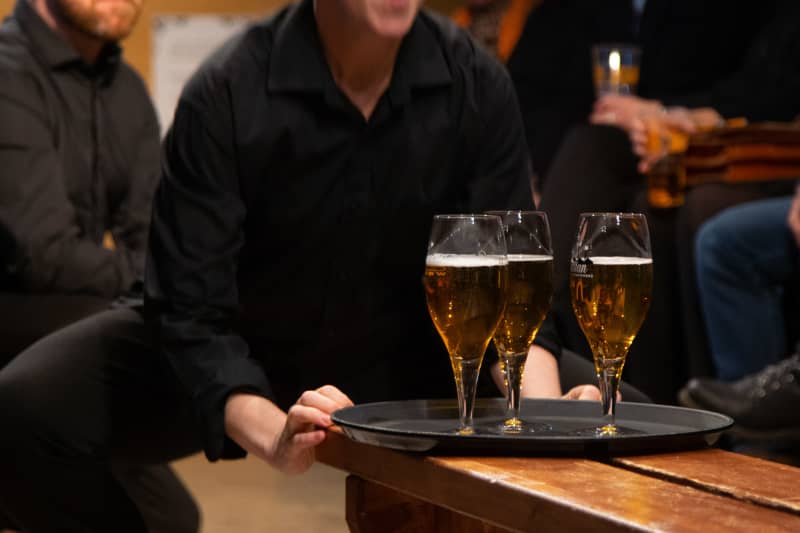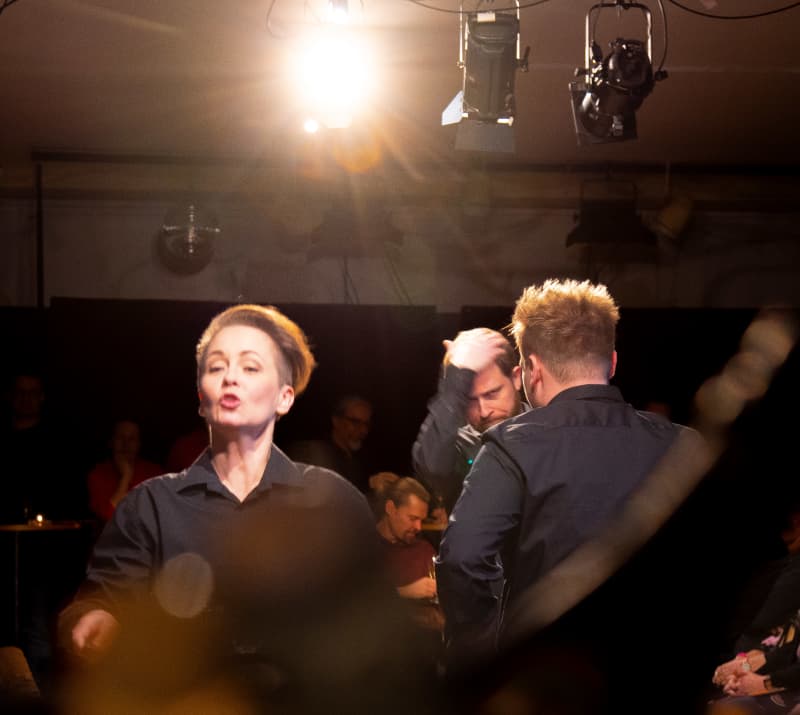Turku Linnateatteri’s play Kiviä kännissä (Drunk on Stone) was already the talk of the town before its premiere because of its exceptional concept. The first thing is to draw lots to see who will drink alcohol during the performance.
The audience cheers the actor on with applause as he pulls a rather creatively constructed drink down his throat in one go.
The drinks include at least red and white wine, clear wine and a splash of beer – straight from the occasional spectator’s pint.
This spring, Turku has seen theatre performances inspired by the UK and the US. The concept, known around the world as Drunk Shakespeare, is known for its unusual set-up, in which an actor drinks himself into a merry drunken stupor while versifying one of Shakespeare’s classics with sober colleagues.

The choice was hit and miss, as the exceptional show caused a small stir even months before the premiere.
Turku Sanomat sent a critic to the premiere, who at the beginning of his review announced that he was an absolutist.
So let’s return to the Linnateatteri stage later.
Tentacle hunting trips cleared at ministerial level
A week ago, Yle published the following news headline: \”Antti Kaikkonen confirms: Get tentacles for him and Lintila.\”
In any case, there is something truly Finnish about it when tentacle hunting trips have to be explained in the news and up to the ministerial level.

In Finland, alcohol is a bigger topic than individual riots, an eternal point of contention in politics, a worrying topic in terms of public health, a normalized substance that everyone has a relationship with in one way or another.
Many drink alcohol as if it were the last day. In 2021, the total consumption in Finland was 9 liters of 100% alcohol for every resident over the age of 15.
Kivi wrote about alcohol in almost all his works
The roots of Finns’ passionate but contradictory relationship with alcohol go back a long way.
Linnateatteri’s artistic director Vahvaselkä states that it was Kive’s production that encouraged them to adapt the alcoholic concept.
– We found only two texts in which alcohol was not mentioned at all. Then again, for example Seitsemän veljes or Nummisutarit – we are there many times over drinks.

According to Vahvaselkä, the working group is quite aware of the dark sides of the subject.
– The purpose is not to glorify alcohol and its use, but the show considers it a natural part of life, which it is. Alcoholism is a hugely problematic disease for the surrounding environment and for the person himself.
Liquor is ultimately irrelevant
In reality, Kiveä kännä is a theatrical performance that uses improvisation, based on the dynamics and professionalism of the actors. It is a surprisingly small side fact that alcohol is drunk on stage. The purpose seems to be mainly to electrify the atmosphere.
Each show is different, among other things, because the actor dealing with hard liquor is drawn at the beginning of the show. On Wednesday, Joonatan Perälä got the role of the drinker.

After the performance, the trio reveals that there is theater magic involved if necessary. The lottery won’t hit if the situation calls for it.
– For example, there are evenings when I drive to my children after the show, says Emmi Kangas.
The duration of the performance is 75 minutes, so even common sense says that there will be a little high-pitched, hip-cracking \”even at worst\”.
– It would be a different matter if the actor was frolicking on stage with a decent head. Then the setting could cause discomfort in the audience, Perälä estimates.
– Safety is the right word here. The presentation has agreed frames within which it can be applied, Kangas underlines.
According to Thomas Dellinger, the concept does its job, as the space has a liberated atmosphere.
– It’s a bit like we’re at the neighboring bar having a fun evening.
Five stars from Rouva
Judging by the audience’s reactions, Kivea hits and sinks. The audience claps several times during the performance and laughs out loud.
Scenes where someone from the audience is included in the performance cause special joy.
After the initial excitement, many take the opportunity and order a drink from the bar during the performance by raising their hand.
According to artistic director Jussi Vahvaselä, the concept has worked better than he could have hoped. The performance rate has approached eighty percent.
– Corners have been found that people laugh at, and laughing is nice. We have only received positive feedback, and that requires more from Finns than giving negative feedback.

After the performance, the audience seems elated. As a result of a quick survey, it can be stated that the presence of alcohol was felt to be suitable for this performance, even if it would otherwise be avoided.
One lady gives what she sees a full five stars.
